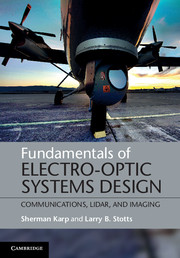Book contents
- Frontmatter
- Contents
- Preface
- Notation
- 1 Genesis of electro-optic systems
- 2 Role of electromagnetic theory in electro-optics systems
- 3 Photo-detection of electromagnetic radiation
- 4 Metrics for evaluating photo-detected radiation
- 5 Contrast, visibility and imaging
- 6 Signal modulation schemes in optical communications
- 7 Forward error correction coding
- 8 Modern communications designs for FOC/FSOC applications
- 9 Light detection and ranging
- 10 Communications in the turbulence channel
- 11 Communications in the optical scatter channel
- Appendix A Two-dimensional Poisson processes
- Appendix B Propagation of finite beams in water
- Appendix C Non-Lambertian scattering
- Appendix D Communications noise sources besides signal/background shot noise
- Index
- References
7 - Forward error correction coding
Published online by Cambridge University Press: 05 February 2013
- Frontmatter
- Contents
- Preface
- Notation
- 1 Genesis of electro-optic systems
- 2 Role of electromagnetic theory in electro-optics systems
- 3 Photo-detection of electromagnetic radiation
- 4 Metrics for evaluating photo-detected radiation
- 5 Contrast, visibility and imaging
- 6 Signal modulation schemes in optical communications
- 7 Forward error correction coding
- 8 Modern communications designs for FOC/FSOC applications
- 9 Light detection and ranging
- 10 Communications in the turbulence channel
- 11 Communications in the optical scatter channel
- Appendix A Two-dimensional Poisson processes
- Appendix B Propagation of finite beams in water
- Appendix C Non-Lambertian scattering
- Appendix D Communications noise sources besides signal/background shot noise
- Index
- References
Summary
When a digital communications system experiences a very noisy/fading channel, the electrical signal-to-noise ratio may never be strong enough to obtain a low probability of detection error. Shannon proved in 1948 that a coding scheme could exist to provide error-free communications under those conditions. In particular, he showed it was possible to achieve reliable communications, i.e., error-free communications, over an unreliable, i.e., noisy, discrete memory-less channel (DMC), using block codes at a rate less than the channel capacity if the number of letters per code word, and consequently, the number of code words, are made arbitrarily large [1]. This result motivated a lot of research to find the optimum code, i.e., one that minimizes the number of letters and code words, to create reliable communications. The various approaches that have emerged from this research form a class of coding best known as forward error correction (FEC) coding (also called channel coding) [2–4]. Richard Hamming is credited with pioneering this field in the 1940s and invented the first FEC code, the Hamming (7,4) code, in 1950. He, and most others, basically has the originator systematically add generated redundant data to its message. These redundant data allows the receiver to detect and correct a limited number of errors occurring anywhere in the message stream without that person requesting the originator to resend part, or all, of the original message. In other words, the FEC provides a very effective means to correct errors without needing a “reverse channel” to request retransmission of data. This advantage is at the cost of a higher channel data rate if one wants to keep the information data rate the same. These techniques are typically applied in communications systems where retransmissions are relatively costly, or impossible, such as in mobile ad hoc networking when broadcasting to multiple receivers (multicast) [5–7], HF communications and optical communications. For the interested reader, Zhu and Kahn provide a detailed summary of FEC coding applied to the turbulence channel [8, Ch. 7, pp. 303–346].
Information
- Type
- Chapter
- Information
- Fundamentals of Electro-Optic Systems DesignCommunications, Lidar, and Imaging, pp. 121 - 140Publisher: Cambridge University PressPrint publication year: 2012
